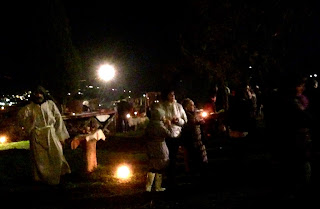I’d seen the posters around town – Presepe Vivente a San Giovenale, and my curiosity was poked.
I walk to the piazzetta in front of San Giovenale everyday as a kind of pilgrimage to a spectacular panorama; so varied, harmonious, and breathtakingly beautiful that watching it becomes a form of meditation. I had seen things going on in the garden immediately below, cliff-side of the old church – little huts being constructed, piles of fire wood collected – and wondered what that was about. I never put it together with the Presepe Vivente.
My actor friend Andrea Brugnera (way to the left in the photo) emailed me day before yesterday. He’s been in Perugia rehearsing, wanted to let me know that he was in town for a few days and maybe we’d see each other at the Presepe Vivente. He’d be there as a figurante (a costumed participant). That was the focus I needed. I checked the posters for time and showed up a few minutes late. Hundreds of people were streaming towards the church. I was already excited.
First, a little background. San Giovenale is Orvieto’s oldest church, originally put up in the mid 1,000’s. Like the Duomo and Sant’Andrea, it’s believed to have been built on Roman foundations that, in turn, sit on Etruscan ones. I suspect that well before the Etruscans put up their temples, a previous people worshipped there, too. You can sense thousands of years of holy ground when you go into any of those churches. How they celebrated, or what their concept of the divine was, hardly matters. Persistence leaves its traces.
The open space to the fore of San Giovenale used to hold community gardens. Orvieto was filled with cultivated land; private gardens associated with a house, great or small, as well as large vineyards and orchards on the outskirts. Most of those larger tracts were located along the cliffs’ edge. The cliffs have never been absolutely stable, and I suspect houses were kept away because losing a patch of vineyard to a slide was less traumatic than losing your guest room — and maybe your guest with it.
After the second world war, the cliffs were reinforced with masonry and concrete, and most of the vineyards, orchards, and public gardens were filled in with houses and apartments. (Not always in that order.) The private gardens are largely still around, but can only be glimpsed briefly through open gates. The garden in front of San Giovenale is one of the few open gardens that survived. It’s now designated as a park.
It was in that park that the Presepe Vivente was held. I brought my American skepticism with me in case I began to feel foolish being there. I imagined something like the living Nativities that I saw as a kid, populated by twitching seven year old Josephs, shepherds in bathrobes, and sleepy Marys. My skepticism didn’t hold up very well. As soon I was on the descending entrance path, lined with torches and potted flames, enchantment began to take over.
The park had been transformed into an Italian notion of what Bethlehem might have been like had the Nativity taken place in the high middle ages, and all the buildings had been of straw. But the people made it alive. There were dozens of Orvietani in costume. They were grilling meat, drizzling toast with (excellent) olive oil, and ladling out mulled spiced and honied wine into little plastic cups. They were carding and spinning wool next to sheep who ostensibly had provided it. They were collecting persimmons and grinding things in mortars using pestles. There were heaps of baskets, and tables laden with wooden dish-ware and terra cotta. Watching over it all were a couple of red-crested Roman soldiers, ready perhaps to quell a riot — or to slap a skeptical American back into reality.
Nobody was pretending anything, they were just hanging out as they were, being themselves in this fancifully created environment, and it worked (acting students, take note.) None of it was convincingly Aramaic or of the time of Augustus, but it was so unselfconsciously festive, how could I be skeptical? Why would I want to be?
Curve around back towards the elevated entrance and you’ll discover beneath it two natural grottos. They served as a manger, the presepe.
I wasn’t able to see the figuranti there until after the story had been acted out, the crowds were too thick. But there was a real infant (though clearly, and thankfully, a bit more than a few days old) a lovely couple (Mary on the plump side and quite beautiful) a laggard shepherd or two carrying lambs, and a few angels (way more relaxed than you find in Renaissance art, but why not?) I missed the arrival of the magi, but ladies on the ledge above sang hauntingly, and the flames, the smoke, the visitors, the costumes, and the sheer exuberance of it all, made missing the story of no consequence. The celebration of the coming of the light was in the simple joy of being there.



